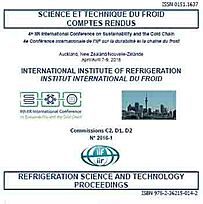
Document IIF
Entreposage frigorifique : une solution à la fois souple et efficace sur le plan énergétique.
Cold storage, a flexibility and energy efficiency solution.
Auteurs : QUARO B.
Résumé
Energy needs for cold production are constantly increasing. In France, the annual electricity consumption within this sector exceeds 15 TWh. Energy storage has become an important way for increasing the flexibility of final energy use and production systems. In order to tackle the problem of cold storage adoption, a software tools has been developed to estimate financial and energy gains if a cool storage facility is installed within a facility (mainly for positive temperature warehouses). The purpose of this tool is to allow industrials to have an objective tool which compares several technologies, and to quickly evaluate the benefits of cold storage
solutions. The tool uses physical energy conservation laws applied to the cooling and storage systems, the electrical load profile of the industrial site, an estimated cold storage capacity, as well as the electricity tariff. Different scenarios of storage charge and discharge are simulated. Different study cases showed cool storage allows considerable energy savings, particularly in Agro-food industry and Supermarkets. Added to this, temperature drift in the stored products and the potential impact on stored product quality is also being investigated.
Documents disponibles
Format PDF
Pages : 8
Disponible
Prix public
20 €
Prix membre*
Gratuit
* meilleur tarif applicable selon le type d'adhésion (voir le détail des avantages des adhésions individuelles et collectives)
Détails
- Titre original : Cold storage, a flexibility and energy efficiency solution.
- Identifiant de la fiche : 30017551
- Langues : Anglais
- Source : 4th IIR International Conference on Sustainability and the Cold Chain. Proceedings: Auckland, New Zealand, April 7-9, 2016.
- Date d'édition : 07/04/2016
- DOI : http://dx.doi.org/10.18462/iir.iccc.2016.0024
Liens
Voir d'autres communications du même compte rendu (63)
Voir le compte rendu de la conférence
-
Reducing energy demand using cooling efficientl...
- Auteurs : AXELROD J. P., MAIDMENT G. G.
- Date : 24/08/2019
- Langues : Anglais
- Source : Proceedings of the 25th IIR International Congress of Refrigeration: Montréal , Canada, August 24-30, 2019.
- Formats : PDF
Voir la fiche
-
Colisage et palettisation à des températures po...
- Auteurs : BOECKAERT D., GAEREMIJN E.
- Date : 20/08/1995
- Langues : Français
- Source : For a Better Quality of Life. 19th International Congress of Refrigeration.
- Formats : PDF
Voir la fiche
-
Off grid long term pear storage; feasibility st...
- Auteurs : GEIJN F. van de, LUKASSE L. J. S.
- Date : 11/04/2022
- Langues : Anglais
- Source : 7th IIR International Conference on Sustainability and the Cold Chain Online. Proceedings: April 11-13 2022
- Formats : PDF
Voir la fiche
-
Thermal energy storage strategies and their ben...
- Auteurs : ZHANG J., CHEN H.
- Date : 21/08/2011
- Langues : Anglais
- Source : Proceedings of the 23rd IIR International Congress of Refrigeration: Prague, Czech Republic, August 21-26, 2011. Overarching theme: Refrigeration for Sustainable Development.
- Formats : PDF
Voir la fiche
-
ACCUMULATION THERMIQUE INSTABLE DANS L'OSSATURE...
- Auteurs : NOMURA T., MURAKAMI Y., UCHIKAWA M.
- Date : 1987
- Langues : Japonais
- Source : Trans. JAR - vol. 4 - n. 1
Voir la fiche
